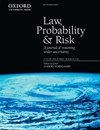刑事证据标准中的信息经济学
IF 1.4
4区 社会学
Q1 LAW
引用次数: 1
摘要
本文将刑事证明标准建模为双重标准,即前置事实的充分概率和充分的信息性。本文的重点是后一种需求,我们使用决策理论来开发一个足够信息的模型。我们证明充分的信息本质上是一个信息经济学和可转换性的问题。在我们的模型中,充分的信息性是对进一步调查的成本效益分析,包括对这些调查产生证据的可能性的预测,这些证据将决定从定罪转向无罪。批评贝叶斯方法的人声称,“重量”不能在贝叶斯模型中被捕获。与这种说法相反,我们的模型显示了如何将足够的信息量建模为二阶概率。本文章由计算机程序翻译,如有差异,请以英文原文为准。
Information economics in the criminal standard of proof
In this paper we model the criminal standard of proof as a twofold standard requiring sufficient probability of the factum probandum and sufficient informativeness. The focus of the paper is on the latter requirement, and we use decision theory to develop a model for sufficient informativeness. We demonstrate that sufficient informativeness is fundamentally a question of information economics and switch-ability. In our model, sufficient informativeness is a cost-benefit-analysis of further investigations that involves a prediction of the possibility that such investigations will produce evidence that switches the decision from conviction to acquittal. Critics of the Bayesian approach to legal evidence have claimed that ‘weight’ cannot be captured in a Bayesian model. Contrary to this claim, our model shows how sufficient informativeness can be modelled as a second order probability.
求助全文
通过发布文献求助,成功后即可免费获取论文全文。
去求助
来源期刊

Law Probability & Risk
MATHEMATICSSTATISTICS & PROBABILITY&-STATISTICS & PROBABILITY
CiteScore
2.10
自引率
28.60%
发文量
8
期刊介绍:
Law, Probability & Risk is a fully refereed journal which publishes papers dealing with topics on the interface of law and probabilistic reasoning. These are interpreted broadly to include aspects relevant to the interpretation of scientific evidence, the assessment of uncertainty and the assessment of risk. The readership includes academic lawyers, mathematicians, statisticians and social scientists with interests in quantitative reasoning.
The primary objective of the journal is to cover issues in law, which have a scientific element, with an emphasis on statistical and probabilistic issues and the assessment of risk.
Examples of topics which may be covered include communications law, computers and the law, environmental law, law and medicine, regulatory law for science and technology, identification problems (such as DNA but including other materials), sampling issues (drugs, computer pornography, fraud), offender profiling, credit scoring, risk assessment, the role of statistics and probability in drafting legislation, the assessment of competing theories of evidence (possibly with a view to forming an optimal combination of them). In addition, a whole new area is emerging in the application of computers to medicine and other safety-critical areas. New legislation is required to define the responsibility of computer experts who develop software for tackling these safety-critical problems.
 求助内容:
求助内容: 应助结果提醒方式:
应助结果提醒方式:


